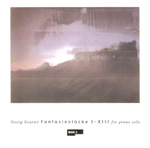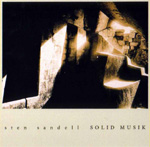| |
Sten Sandell & Georg Graewe : Nuscope Pianists Look Forward Through
the Past
by James Beaudreau
February 2004
The history of jazz, tied up as it is with the invention and development
of recording technology, is preserved in many legendary recordings.
Of those, there is a special strain given to great solo piano performances.
There's Art Tatum's "Tiger Rag" (1933), Lennie Tristano's
"Turkish Mambo" (1954 or '55), Keith Jarrett's Köln
Concert (1975) and Cecil Taylor's Willisau Concert (2002).
In fact, technology has afforded us an embarrassment of riches. With
that debt in mind, I sometimes think of the improvisations lost to
time, before cylinders and tape and the MiniDisc. What of the great
old men of music known for their improvisational prowess: Bach, Mozart,
Beethoven?
 In his
short essay "Impromptu" in the booklet of Georg Graewe's
Fantasiestücke I-XIII, improvising musician Fred Van Hove
writes, "Ladies and Gentlemen, we have come far from the early
days of free improvised music some 40 years ago with its total cluster
playing. Free improvisation is as adventurous as before, and now it
has become adult and Georg proves it." It's an interesting
idea, though I believe "adult" is a poor choice of words—consider
Cecil Taylor, for one, whose music is largely based around clusters
of sound: is it possible to call his music anything but adult or fully
developed? Yet I believe I understand what Van Hove is getting at:
a return to tonal expression in non-idiomatic improvisation. Derek
Bailey, an original practitioner of non-idiomatic improvisation, developed
a new musical language of traditionally non-musical sounds, based
on extended technique. Forty years ago, musicians like Bailey wished
to break as far away from the sound of known music in order to free
themselves from its trappings. But now that time has passed and the
extra-musical has developed its own orthodoxies, musicians can perhaps
be less burdened by tonal associations and can explore the twelve
tones in peace. Or so it seems in these two new recordings. In his
short essay "Impromptu" in the booklet of Georg Graewe's
Fantasiestücke I-XIII, improvising musician Fred Van Hove
writes, "Ladies and Gentlemen, we have come far from the early
days of free improvised music some 40 years ago with its total cluster
playing. Free improvisation is as adventurous as before, and now it
has become adult and Georg proves it." It's an interesting
idea, though I believe "adult" is a poor choice of words—consider
Cecil Taylor, for one, whose music is largely based around clusters
of sound: is it possible to call his music anything but adult or fully
developed? Yet I believe I understand what Van Hove is getting at:
a return to tonal expression in non-idiomatic improvisation. Derek
Bailey, an original practitioner of non-idiomatic improvisation, developed
a new musical language of traditionally non-musical sounds, based
on extended technique. Forty years ago, musicians like Bailey wished
to break as far away from the sound of known music in order to free
themselves from its trappings. But now that time has passed and the
extra-musical has developed its own orthodoxies, musicians can perhaps
be less burdened by tonal associations and can explore the twelve
tones in peace. Or so it seems in these two new recordings.
 When
I listen to Graewe's Fantasiestücke I-XIII and Sten
Sandell's Solid Musik, I imagine a line, tracing back
in time, through Schoenberg, Bartok, Beethoven, and Mozart; eventually
coming to rest at J.S. Bach. There is a quality of naked musical thinking
in both Graewe's and Sandell's playing that is, in its economy and
poise, almost classical. Georg Graewe, who is German, has led a busy
international musical life since his professional debut in 1974. His
is a wide contemporary scope: compositions for orchestra and theatre
scores, chamber music and various jazz settings. He has worked with
notable artists such as Anthony Braxton and Hamid Drake. Though jazz
is an integral part of his musical universe, it is not much in evidence
in Fantasiestücke I-XIII, his third solo recording. Rather,
we're treated to a pianist with a sure, serene touch, a completeness
of thought and a classical sense of balance. Sandell, a Swede, started
his career in 1976, touring internationally and playing with forces
as diverse as Mats Gustafsson and Chris Cutler. His sound is elemental,
and he plays a more experimentally dramatic music of balanced extremes.
Both pianists speak an oblique harmonic language, a vocabulary closer
to Schoenberg than Tatum. It's like listening to jumbled English:
there's a litany full of familiar words, but with the grammar broken
apart and reassembled. One must rely exclusively on the sound
of the words and surrender the ties to their former meanings. Both
men balance the full range of the piano; Graewe as if he's trying
to recall and map an instant's glimpse of the night sky, and Sandell
as if he's chasing cracks in the surface of an icy pond. When
I listen to Graewe's Fantasiestücke I-XIII and Sten
Sandell's Solid Musik, I imagine a line, tracing back
in time, through Schoenberg, Bartok, Beethoven, and Mozart; eventually
coming to rest at J.S. Bach. There is a quality of naked musical thinking
in both Graewe's and Sandell's playing that is, in its economy and
poise, almost classical. Georg Graewe, who is German, has led a busy
international musical life since his professional debut in 1974. His
is a wide contemporary scope: compositions for orchestra and theatre
scores, chamber music and various jazz settings. He has worked with
notable artists such as Anthony Braxton and Hamid Drake. Though jazz
is an integral part of his musical universe, it is not much in evidence
in Fantasiestücke I-XIII, his third solo recording. Rather,
we're treated to a pianist with a sure, serene touch, a completeness
of thought and a classical sense of balance. Sandell, a Swede, started
his career in 1976, touring internationally and playing with forces
as diverse as Mats Gustafsson and Chris Cutler. His sound is elemental,
and he plays a more experimentally dramatic music of balanced extremes.
Both pianists speak an oblique harmonic language, a vocabulary closer
to Schoenberg than Tatum. It's like listening to jumbled English:
there's a litany full of familiar words, but with the grammar broken
apart and reassembled. One must rely exclusively on the sound
of the words and surrender the ties to their former meanings. Both
men balance the full range of the piano; Graewe as if he's trying
to recall and map an instant's glimpse of the night sky, and Sandell
as if he's chasing cracks in the surface of an icy pond.
Sandell's Solid Musik contains eight individual improvisations,
ranging in length from three-and-a-half to sixteen minutes. He possesses
an acute clarity of line, and takes advantage of it with stunning
improvised counterpoint: in "Not Liquid" (all but one
of the pieces' titles have a Tao-like negative qualifier), the
pianist begins with one voice, which quickly splits into two, and
then three, bringing to mind Bach's three-part inventions. But
the accord between the voices is precarious. After a line is born
of another, an easy orbit between them usually lasts only a short
time before some anomaly in one or the other sends them wobbling through
distant dissonances and registers; yet Sandell accepts their ramifications,
and seeks balances, or lets the lines fly away. It's a marvelous
display. He also possesses an exquisite touch at the piano. On Solid
Musik he uses a Baldwin SD-10 from which he draws luxurious sound
qualities: the left hand sometimes sounds as if it's pulling
the strings of a lute; the right, especially in the crystalline extreme
upper register, hammers out notes like rain on a windshield. He is
also an explorer of extended technique and silence. In some of his
improvisations he seems to run his lines right off the piano, where
they tumble into percussion pieces on the piano's case; at other times
his sensitivity to sound shows itself in the exquisitely long decays
he allows his chords.
As the title Fantasiestücke I-XIII suggests, Georg Graewe
applies himself to the realization of thirteen numbered impromptus
(to use Fred Van Hove's word). Graewe's approach to the art is more
sober than Sandell's, and perhaps more easily beautiful. He is the
more romantic of the two; which is not to say that he thunders and
emotes at the keyboard, but that in his art he seems to give voice
to subtle inner states. If his virtuosity is less compelling than
Sandell's, he makes up for it with a greater sense of solidity in
his music. To make a jazz comparison, Graewe is like Bill Evans to
Sandell's Jaki Byard. Though there are marked exceptions in some of
his improvisations, the meat of Graewe's exposition takes place in
the middle of the keyboard. He arrives, in the more languorous pieces,
like "VIII" and "XII", at a completeness of expression
that puts me in mind of some of the preludes in Bach's Well Tempered
Clavier. When he chooses to explore less stable avenues, as in
"X", in which bubbling trails escape from the piano like
air bubbles from deep sea vents, he does so with intelligent determination
and thematic composure.
These two practitioners of non-idiomatic improvisation have much to
offer. The improvisations of the old masters of Western music will
never be recovered, but greatness in the work of the living can give
us much to imagine. Graewe and Sandell reveal powerful currents of
creativity in the world today, and through those currents provide
new fuel for the old masters' myths while simultaneously kindling
their own.
|
|
|
|
|

